Posts Tagged ‘nutrition’
Monday, November 21st, 2011
Vitamins regulate a variety of essential bodily functions. They are crucial in many of our metabolic processes so that we can benefit from the energy in our foods. Vitamins are also very important in helping to build our bones, teeth, skin, blood and many other vital body tissues.
Vitamins are classified as either water soluble or fat soluble based on how they are absorbed and used by the body.
This week we focus on the fat soluble vitamins. Join us in two weeks to learn more about water soluble vitamins.
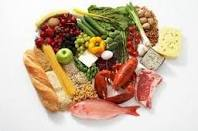
Fat Soluble (Vitamins A, D, E and K): Fat soluble vitamins are those that are normally stored in the body.
When these vitamins are ingested, they dissolve in fat. In a person with a healthy digestive system, the body uses what it needs at that time and stores the rest for future use.
In this blog, we explain the why we need each fat soluble vitamin and which foods are good sources of them.
|
Name
|
Why do we need it?
|
Where do we find it?
|
|
Vitamin A
|
It is important in helping with the moisturisation of our skin and mucous membranes (lining of the nose, eyes, throat).
Vitamin A also helps with night vision.
It is an antioxidant, which means that it protects against the effects of “free radicals” (unstable compounds that can damage healthy body cells).
Vitamin A also increases our immunity.
|
It is stored in our liver, so the liver of other animals is a rich source of vitamin A.
The animal source is known as retinol, and is also found in eggs, oily fish (e.g. mackerel), butter and milk.
The main plant source of vitamin A is known as beta-carotene and is found in orange/red fruit and vegetables (e.g. carrot, sweet potato, red pepper).
|
|
Vitamin D
|
Regulates and improves the uptake of calcium and phosphate in our bodies for healthy bones and teeth.
Important for pregnant and breastfeeding mothers to assist with the child’s bone development because babies can’t produce the vitamin D in their skin.
|
Sunlight (we make vitamin D in our skin), oily fish, liver, fortified products (e.g. breakfast cereal, margarine), eggs, baby milk formula.
|
|
Vitamin E
|
It helps to maintain our reproductive system, nerves and muscles.
Similar to vitamin A, vitamin E is also an antioxidant.
|
Nuts, seeds, plant oils (e.g. olive oil, corn oil), wheatgerm, some green leafy vegetables
|
|
Vitamin K
|
Important for helping our blood to clot properly (healing wounds) and in the formation of our bones and kidney tissues.
|
Green leafy vegetables (e.g. broccoli, spinach), vegetable oils, cereals. Small amounts in pork and cheese.
|
Tags: 5 a day, carlow, fat soluble, fruit, healthy eating, kilkenny, nutrition, nutritional concepts, vegetables, vitamins
Posted in General | Comments Off
Monday, November 7th, 2011
A calorie is simply the unit that we use to measure energy.
|
All foods have a ‘calorific value’ and this is simply the amount of calories (energy) that a food will supply your body when it is eaten. Food labels on packaged foods usually list the energy content in two units; one is kcals (calories) the other is in kj (joules).
|
|
Your body needs energy to be able to fuel metabolic pathways that enable the body to work properly. We are all individuals and we have our own unique metabolic rate (this is the rate at which our body consumes calories per day). The average person’s metabolic rate is approximately 2000 calories per day.
The simple truth is that there is a ‘balance of energy’ in your body, if you burn more or less calories (through activity) than your body consumes daily (through food), you will lose or gain weight accordingly.
So how do you ‘burn’ calories?
There are a number of reasons why calories are burned in your body.
- Your body requires a certain number of calories per day to simply stay alive. This is called Basal Metabolic Rate (BMR). Your body burns these calories to maintain the most basic functions of your body such as breathing, blood circulation and brain activity.
- The rest of the calories are ideally burned through exercise and activity. Everything you do results in you burning calories – washing up, hoovering, climbing the stairs, anything that involves movement will contribute to the total calories burned by the body.

Tags: activity, balance, calories, carlow, diet, energy, food label, healthy eating, kilkenny, nutrition, nutritional concepts
Posted in General | Comments Off
Monday, October 24th, 2011
Preparation: 10 mins | Cook: 1 hour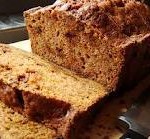
Ingredients
- 200g plain flour
- 1 ¼ teaspoons bicarbonate of soda
- 1 teaspoon salt
- 1 teaspoon ground cinnamon
- ½ teaspoon ground nutmeg
- 255g pureed pumpkin
- 200g dark brown soft sugar
- 110ml buttermilk
- 1 egg
- 2 tablespoons butter, softened
Method
- Preheat oven to 180°C.
- Sift the flour, bicarbonate of soda, salt, cinnamon and nutmeg into a large bowl.
- Mix in the pumpkin, brown sugar, buttermilk, egg and butter until well blended. Pour into a 9×5 inch loaf tin and smooth the top.
- Bake for 1 hour in preheated oven, or until a cocktail stick inserted into the centre comes out clean.
Tags: calories, carlow, diet, halloween, healthy eating, kilkenny, nutrition, nutritional concepts, pumpkin, tasty
Posted in Recipes | Comments Off
Monday, October 10th, 2011
When you go to college or university it may be the first time you’ve lived away from home and been fully independent. To have enough energy to study and enjoy student life to the full you need to eat regularly and healthily!
What does a healthy balanced diet really mean?
- Eat regularly and base your meals on starchy foods
- Eat lots of fruit and vegetables
- Eat a wide variety of foods

- Try to eat less salt
- Cut down on saturated fats and sugars
- Get active and try to be a healthy weight
- Drink plenty of water
- Don’t skip breakfast
Get organised
- With some planning you can eat cheap and healthy meals on a tight budget
- Make a shopping list before you go and shop
- Watch your waste – when you buy foods that go off quickly, plan your meals carefully so it gets eaten or frozen straight away
- Vary your meals otherwise you will get bored of eating and cooking the same things over and over again
What could you have in your food cupboard?
You need to stock your cupboard and fridge with easy to cook ingredients. Suggestions of meals include:
- Soups – easy to make and nutritious especially if you add a lot of vegetables (fresh, frozen or canned).
- Pasta – it’s quick and easy to cook and prepare. Keep pasta sauces in your cupboards and add your own flavours, vegetables etc. to it
- Rice – mix cooked rice with leftover vegetables and meat
- Bread is a good source of carbohydrate. Choose wholemeal bread rather than white as it is more nutritious and filling.
- Potatoes – Baking potatoes are great value and versatile.
- Porridge oats – cheap and it’s a really filling meal to start the day with. You could add some fresh or dried fruit for variety.
- Beans and lentils – cheap to buy and a small amount goes a long way! Canned varieties can make a quick and nutritious addition to soups and stews. Lentils and beans can be used as a main meal with vegetables added. Baked beans on toast is a classic and is actually a very healthy dish, especially if you use wholemeal bread, and low fat spread.
- Vegetables and fruit – can add vegetables to curries, soups, stir fries. Canned and frozen vegetables can be used as additions to last minute meals. Fruit is excellent for a quick nutritious snack. We should be eating at least 5 pieces of fruit and vegetables per day.
- Condiments – add taste and flavour to your cooking. Keep a selection of dried herbs, spices, curry powder, vinegars, tomato sauce, soy sauce and stock cubes in your cupboard.
- Tinned tomatoes – these can form the base of all sorts of sauces, are low in fat and count as a portion of your fruit and vegetables.
- Chicken – chicken seems to be of better value if you buy in larger quantities. If you’ve got a freezer you could chop it up and freeze it in small amounts.
- Eggs – are easy to cook and versatile.
- Canned fish – Mackerel, sardines and pilchards are good sources of protein and omega 3 fatty acids.
- Milk – full of calcium and vitamins and is healthy drink at any time of the day. Choose semi-skimmed or skimmed milk for a lower fat option.
Tags: 5 a day, activity, budget, carlow, college, cooking, diet, energy, fat, fruit, healthy eating, kilkenny, low fat, nutrition, nutritional concepts, saturated fat, starchy, student, university, vegetables
Posted in General | Comments Off
Monday, September 26th, 2011
Serves 6
Ingredients –
1 tbsp low fat spread
1 large onion, finely chopped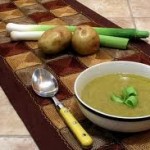
500g leeks, finely chopped
500g floury potatoes, peeled and chopped
3 tbsp chopped fresh parsley
1 litre of hot vegetable stock
300ml skimmed milk
Salt and freshly ground pepper
Method –
- Melt the low fat spread in a large, lidded, non stick saucepan and gently sauté the onion and leeks until soft, about 10 minutes.
- Add the potatoes, parsley and hot stock and bring to the boil. Cover and reduce the heat. Simmer gently for about 20 minutes.
- Add the milk to the saucepan and reheat gently. Season to taste and serve garnished with parsley sprigs.
Tags: carlow, diet, healthy eating, kilkenny, leek, lose weight, low fat, nutrition, nutritional concepts, potato, soup, tasty, vegetables, winter
Posted in Recipes | Comments Off
Monday, August 29th, 2011
Eating too much fat increases amongst other things your risk of heart disease and encourages weight gain.
Research has shown that our diet generally contains too much fatty food and that we can all benefit from eating less fat.
Instead of getting our energy from starchy foods (carbohydrates) like bread and potatoes, we rely too much on foods that are high in animal fats such as red meat, butter and cheese.
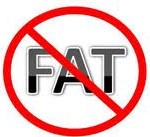
Tips for reducing fat intake:
- Choose lean meat. Trim all visible fat from meat and poultry prior to cooking.
- Choose low fat milk; choose semi-skimmed or skimmed milks.
- Choose low fat yoghurts.
- Choose low fat spread.
- Fry very occasionally using olive, sunflower or rapeseed oil. Choose grilling or baking instead.
- Beware of the hidden fats in biscuits, cakes, chocolate, pastry and savoury snacks. Always read your food labels.
- Fill up on fruit and vegetables.
- Look out for low fat snacks, low fat yoghurt and fruit.
- Use oven chips rather than fried.
Tags: calories, carlow, diet, fat, food label, fruit, healthy eating, kilkenny, lose weight, low fat, nutrition, nutritional concepts, vegetables
Posted in General | Comments Off
Sunday, July 31st, 2011
Serves 4
Ingredients -
350g chicken breast, chopped into bite sized pieces
1 garlic clove, crushed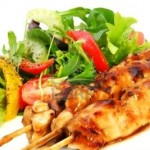
2 tbsp dark soy sauce
1 tsp dried chilli flakes
2 tbsp crunchy peanut butter
1 tbsp tomato puree
100ml pineapple juice
Method -
- Place the chicken in a shallow dish.
- Mix together the garlic, soy sauce, chilli flakes, peanut butter, tomato puree and pineapple juice. Pour the mixture over the chicken and toss well to coat all of the chicken pieces. Cover and leave to marinate for 30 minutes.
- Preheat the grill to high. Place the chicken pieces onto wooden skewers. Put them under the grill for 15 minutes, turning frequently, until evenly browned and cooked through.
Tags: carlow, chicken, healthy eating, kilkenny, low fat, nutrition, nutritional concepts, tasty
Posted in Recipes | Comments Off
Monday, July 18th, 2011
- Eat fewer fried and fatty foods such as cream, butter, full-fat dairy products, fatty red meat, cakes, biscuits and takeaways – and find lower-fat alternatives instead.
- If you have to use oil, go for one that is packed with monounsaturates such as olive oil or rapeseed oil.
- Eat five servings of fruit and vegetables every day – they are low in fat and calories but will help to fill you up.
- Go for high-fibre carbohydrates such as wholemeal bread, wholegrain cereals, brown rice and wholewheat pasta. They are far more filling than the white stuff.
- Start your day with a bowl of porridge.
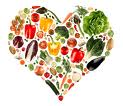
- Use a little less meat in dishes like stews, soups and casseroles and add barley, lentils or beans instead.
- Eat oily fish once a week. Lunch on sardines with toast or serve salmon for dinner.
- Slash the salt content of your diet – check salt levels before you buy.
- If you drink, stick to sensible limits – that means no more than 3-4 units a day for men and 2-3 units daily for women.
Tags: 5 a day, alcohol, carlow, diet, energy, fat, fruit, healthy eating, healthy heart, kilkenny, low fat, nutrition, nutritional concepts, portion, vegetables, vitamins and minerals
Posted in General | Comments Off
Monday, July 4th, 2011
The best way to eat if you want to banish tiredness is to have a healthy, balanced diet that contains foods from four main food groups in the right proportions.
The four food groups are:
- potatoes, bread, rice, pasta and other starchy foods
- fruit and vegetables
- milk and dairy foods
- meat, fish, eggs, beans and other non-dairy sources of protein

- Eat at regular intervals.
- Start the day well with breakfast.
- Aim for 5 a day with fruit and vegetables.
- Say no to sugar.
- Watch your intake of alcohol.
- Eat enough for your activity level.
Tags: 5 a day, activity, alcohol, calories, carlow, diet, energy, fruit, healthy eating, kilkenny, nutrition, nutritional concepts, sugar, vegetables
Posted in General | Comments Off
Monday, June 20th, 2011
The school holidays are fast approaching and they can be associated with a lack of routine which can mean that there are more opportunities to eat more food more often. Here are some tips to avoid over-indulging in fatty, sugary, salty and pre-packaged foods that can be tempting alternatives during the holidays.

- Encourage your kids to maintain their school-eating schedule. This can help to stop grazing between meals. Try to stick to a nutritious breakfast, lunch and dinner as well as healthy morning and afternoon snacks.
- When packing the swimming gear or getting ready for the walk to the park, throw in some fresh fruit and vegetables to help with the hunger pangs.
- Encourage your kids to drink more water, rather than fizzy drinks.
- Focus on more activity to help counteract any increased food intake.
- Keep kids occupied as much as possible. Boredom can play a big part in snacking, overeating and drinking.
- Help make mealtimes fun. Let your kids help to plan and prepare a meal.
Tags: activity, carlow, diet, fruit, fun, healthy eating, holidays, kids, kilkenny, nutrition, nutritional concepts, school, snack
Posted in General | Comments Off











